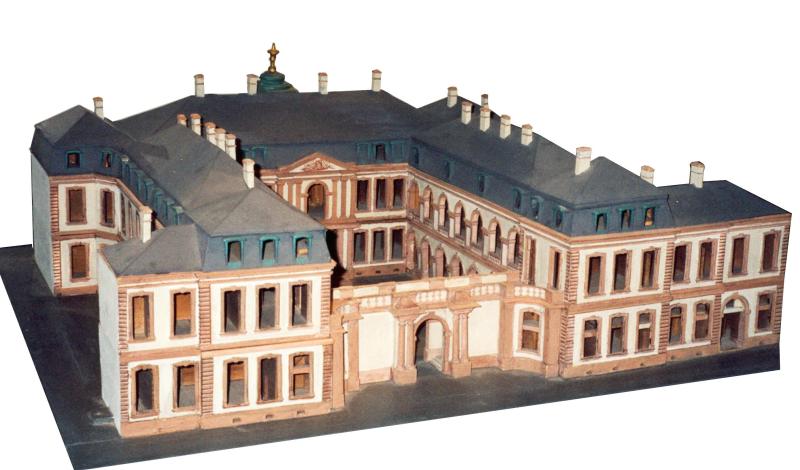Palais Thurn und Taxis on:
[Wikipedia]
[Google]
[Amazon]
 The Palais Thurn und Taxis () in Frankfurt, Germany was built from 1731 to 1739 by
The Palais Thurn und Taxis () in Frankfurt, Germany was built from 1731 to 1739 by
 During 1943 and 1944 the palace was badly damaged in the
During 1943 and 1944 the palace was badly damaged in the
 The Palais Thurn und Taxis () in Frankfurt, Germany was built from 1731 to 1739 by
The Palais Thurn und Taxis () in Frankfurt, Germany was built from 1731 to 1739 by Robert de Cotte
Robert de Cotte (1656 – 15 July 1735) was a French architect-administrator, under whose design control of the royal buildings of France from 1699, the earliest notes presaging the Rococo style were introduced. First a pupil of Jules Ha ...
and commissioned by the Imperial Postmaster, Prince Anselm Franz von Thurn und Taxis (1714–1739).
The building was heavily damaged in World War II and then demolished. Today a reconstruction houses some shops.
History
In 1748 the castle was the administrative seat of the imperial post office, then operated by the Thurn und Taxis family, and from 1805 to 1813 it was the residence of the Prince Primate andGrand Duke of Frankfurt
The Grand Duchy of Frankfurt was a German satellite state of Napoleonic creation. It came into existence in 1810 through the combination of the former territories of the Archbishopric of Mainz along with the Free City of Frankfurt itself.
Histor ...
, Karl Theodor von Dalberg
Karl Theodor Anton Maria von Dalberg (8 February 1744 – 10 February 1817) was Prince- Archbishop of Regensburg, Arch-Chancellor of the Holy Roman Empire, Bishop of Constance and Worms, prince-primate of the Confederation of the Rhine and Gr ...
. After the restoration of the Free City of Frankfurt
For almost five centuries, the German city of Frankfurt was a city-state within two major Germanic entities:
*The Holy Roman Empire as the Free Imperial City of Frankfurt () (until 1806)
*The German Confederation as the Free City of Frankfurt ...
, it held the Bundestag
The Bundestag (, "Federal Diet") is the German federal parliament. It is the only federal representative body that is directly elected by the German people. It is comparable to the United States House of Representatives or the House of Commons ...
of the German Confederation
The German Confederation (german: Deutscher Bund, ) was an association of 39 predominantly German-speaking sovereign states in Central Europe. It was created by the Congress of Vienna in 1815 as a replacement of the former Holy Roman Empire, w ...
from 1816 to 1866. The public was excluded from the meetings. They were chaired by the Austrian envoy, who would live in the castle when the Bundestag was in session.
In 1895 Prince Albert I von Thurn und Taxis sold the Palais to the Imperial Post. In 1905 the city of Frankfurt took over the palace and used it to house the Museum of Ethnology for the collections of the African explorer Leo Frobenius.
Demolition & reconstruction
 During 1943 and 1944 the palace was badly damaged in the
During 1943 and 1944 the palace was badly damaged in the bombing of Frankfurt am Main in World War II
Bombing of Frankfurt am Main by the Allies of World War II killed about 5,500 residents and destroyed the largest half-timbered historical city centre in Germany (the Eighth Air Force dropped 12,197 tons of explosives on the city Bombing the Europ ...
, but much of the structure was preserved, such as some ceiling paintings and stucco. Although reconstruction was possible, it would have been too costly, and so much of the building was demolished in 1951. The remaining parts of the building were actually new buildings made from sections of the original, but with modern reinforced concrete and without the mansard roofs.
From 2004 to 2010 the palais has been reconstructed as part of the Palais Quartier development.
See also
* Palais Quartier *Free City of Frankfurt
For almost five centuries, the German city of Frankfurt was a city-state within two major Germanic entities:
*The Holy Roman Empire as the Free Imperial City of Frankfurt () (until 1806)
*The German Confederation as the Free City of Frankfurt ...
Buildings and structures in Frankfurt
Frankfurt-Altstadt
German Confederation
1739 establishments in the Holy Roman Empire
{{Hesse-struct-stub